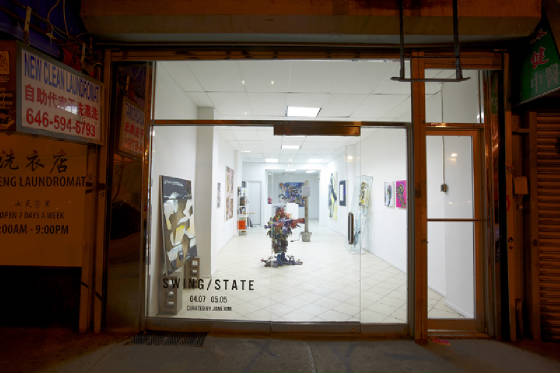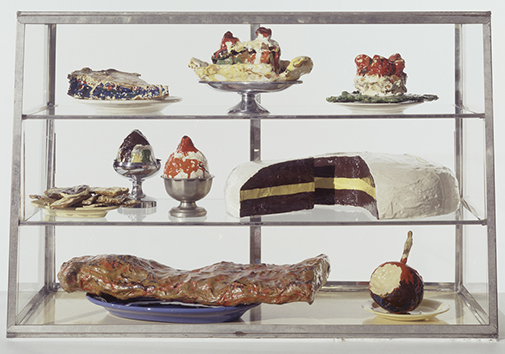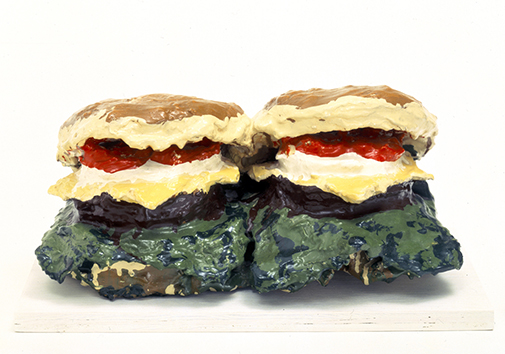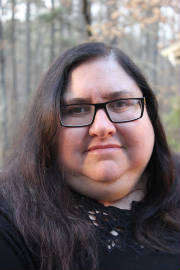|

|
| Exterior View of Jane Kim Gallery, photo: Tom Powel Imaging |
We
live in a pop-up world. Over the past ten years, restaurants, stores, and art
galleries have become nomadic and ephemeral, liable to pop up anywhere at any
time, then disappear after a brief existence, possibly to reappear elsewhere at
another time. As far back as 2003, Target created a pop-up store in Manhattan
to showcase a new line from Isaac Mizrahi. Two airlines, Delta and Song, have
created pop-ups to showcase their new chef-created in-flight menus. You can sometimes
eat cheese fondue in a pop-restaurant aboard a tram in Zurich. Hudson North, a
temporary restaurant in Atlanta’s
Atlantic station, offered farm-to-table fare for three months at the end of
2012. There is currently a national trend of using vacant commercial spaces as
venues for temporary art exhibits, some of which last only one night.
Organizations such as Chicago’s Pop Up
Art Loop, which obtains unused storefronts on the Chicago Loop for exhibitions,
and LAundry, which sponsors temporary shows in laundromats in Los Angeles, are
among the many entrepreneurs of this emergent approach to showing art.
The impermanence of pop-ups creates a sense of both novelty
and
urgency: they allow restaurateurs, retailers, and gallerists opportunities to
try new things at relatively low risk and make their audiences want to try out
their offerings sooner rather than later. But the pop-up phenomenon is also the
product of difficult economic times when it has become increasingly difficult
to establish and sustain businesses, including galleries. Jane Kim is a curator
who returned recently to New York City from Dallas where she has been dealing
with family issues over the past two years. Upon returning, she found the art
world in a different situation than when she left it: the recession had clearly
taken a toll. She also found that there seemed to be a trend of showing young
artists right out of grad school and many significant mid-career artists
without gallery representation.

Interior View, Lisa
Beck’s "At the End of the Day," 2012, Jane Kim Gallery at 119 Hester
Street; photo: Tom Powel Imaging
whom have substantial exhibition records. She curated Swing
State, a pop-up show in a vacant
commercial space on Hester Street in New York’s
Chinatown, flanked by a Chinese grocery and a laundromat. The title punningly refers
to those states that supposedly decide American elections. The show is not a
political call for action, however, but features the work of thirteen artists
of several generations whose work falls into the gray area between abstraction
and representation, including David Diao, Lydia Dona, David Humphrey, Fabian
Marcaccio, Thomas Nozkowski, and Lucas Samaras. The pop-up phenomenon allowed
Kim to buck the trends and show the artists she wishes to show.
The downtown pop-up art show echoes a chapter in the history
of
contemporary art in New York that dates back over fifty years. The Museum of
Modern Art is currently hosting a major exhibition of Claes Oldenburg featuring
his environmental installations The Store,
The Street, and Mouse Museum/Ray Gun Wing. Whereas The Street (1960) was an evocation of the urban environment
made
for a gallery space in the Judson Church and the Mouse Museum was first shown
at Documenta in 1972, Oldenburg set up The
Store, his poetic yet pointed rendition of a typical, inexpensive American
retail business, for the month of December, 1961, in his storefront studio on
East Second Street, only about eight blocks from the Chinatown address where
Kim mounted Swing State. Oldenburg
stocked his store with sculptural objects and reliefs he had made from muslin
soaked in plaster and painted in bright colors and Abstract Expressionist
brushstrokes depicting a full range of consumer goods, especially clothing and
food. Perhaps The Store, an art
installation staged in a disused retail space, was the first pop-up show.

|
| Claes Oldenburg Pastry Case, I Photo: The Museum of Modern Art |
Inside the original Store, and now at MOMA, were an array of
objects one might find in a store: panty hose for something like 99 cents, an
ice cream cone so large it had to be transported on the top of a car, a case
filled with cakes and desserts like in a diner to tempt the viewer with
sweetness. These works create an interesting gap between abstraction and
figuration, between desire for the thing and the thing’s becoming a sculpture.
There is a nice parallel between the hamburgers Oldenburg made in the 1960’s and Untitled (Utencils #73) that
Samaras
made in 2001 and Kim included in Swing
State. Both artists, now elder statesmen of the art world (Oldenburg is 84
and Samaras is 77) play at making things to sell in a store. The connections
between these two artists go back a long time: Samaras performed in Ray Gun
Theater performances Oldenburg created and staged at The Store.

|
| Claes Oldenburg, Two Cheeseburgers, with Everything (Dual Hamburgers)1962 photo:Museum of Modern Art |
In 1961, Oldenburg’s melding of representation and abstraction was the daring move of a young artist. Even
today, art that does not fit comfortably into either category remains provocative. Paintings that swing between abstraction
and representation have always intrigued me. Yet, I am dismayed when viewers treat abstraction like a Rorschach test, always
trying to find the figuration hidden within pure abstraction. On the other hand, I have never minded reading a figurative
work for its abstract qualities, so perhaps the reverse should be valid as well.

Deanna Sirlin is Editor-in Chief of The Art Section. Her forthcoming book,
She's Got What It Takes: Contemporary American Women Artists in Dialogue, will be out in the fall of 2013, published
by Charta Art Books, Milan. She is also an artist.
|
